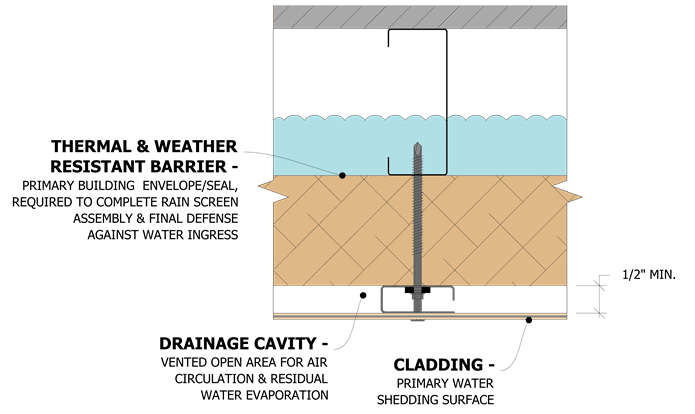Architects and designers seeking better moisture management and energy efficiency from the exteriors of their projects are turning to rainscreens as a solution for both. A rainscreen is an exterior cladding infrastructure that sits away from a building’s exterior wall’s water-resistant barrier, creating an air cavity directly behind the cladding which is vented at both the top and bottom of the wall so it may help to protect the buildings important envelope. This allows any moisture that may pass by the cladding to easily drain away from the building, and the air that moves between the cladding and the wall accelerates evaporation of any residual moisture due to passive ventilation. Rainscreens also provide a solution for improving buildings energy efficiency by facilitating the use, and space for, exterior insulation.
A rainscreen should be viewed as a building envelope support mechanism, whose primary function is not to provide barrier protection against water penetration (such as a weather-resistant barrier does). Rather, a rainscreen is designed to limit the amount of water that could potentially come into contact with the primary building envelope’s moisture barrier, thereby reducing the chance of water finding a way into the wall assembly. It does this by defending the wall assembly against the five forces that drive rain into buildings: kinetic energy, gravity, capillary action, surface tension and pressure gradients.
Knight Wall Systems’ thermally isolated rainscreen solutions are unique systems that not only create an air cavity to help limit the amount of water contacting the buildings primary envelope, but also provides a solution for attaching nearly any type of cladding to extremely efficient support systems, including a solution for true continuous insulation. Thereby dramatically increasing energy efficiency of the building and while protecting the vital and fragile primary building envelope.
Providing limitless design flexibility for a building’s exterior, rainscreen cladding options that can be attached include ACM, fiber cement, UHPC, modern composites, adhered stone veneer and stucco, among many others. The use of rainscreens can potentially contribute to a project’s earning points toward several different LEED Credits and other sustainability goals.
Benefits of Using a Rainscreen Wall System
- Weather-resistant barrier support mechanism keeps moisture away from the wall assembly
- Water vapor behind cladding and insulation can escape by means of evaporation
- Helps reduce hot and cold air and thermal movement through the wall, reducing energy costs
- Enables more insulation, within the stud cavity and more effectively on the exterior of the wall
- Promotes water drainage by channeling moisture to the outside of the wall assembly by means of flashing and the force of gravity
- Air space between exterior cladding and drainage plane helps drainage and facilitates ventilation and drying
- Provides great design flexibility, works with a limitless variety of cladding options for simplified detailing and transitioning between cladding materials
- Reduction in the buildings dead load by use of lightweight cladding options versus traditional building materials (i.e. brick veneer, etc.)

